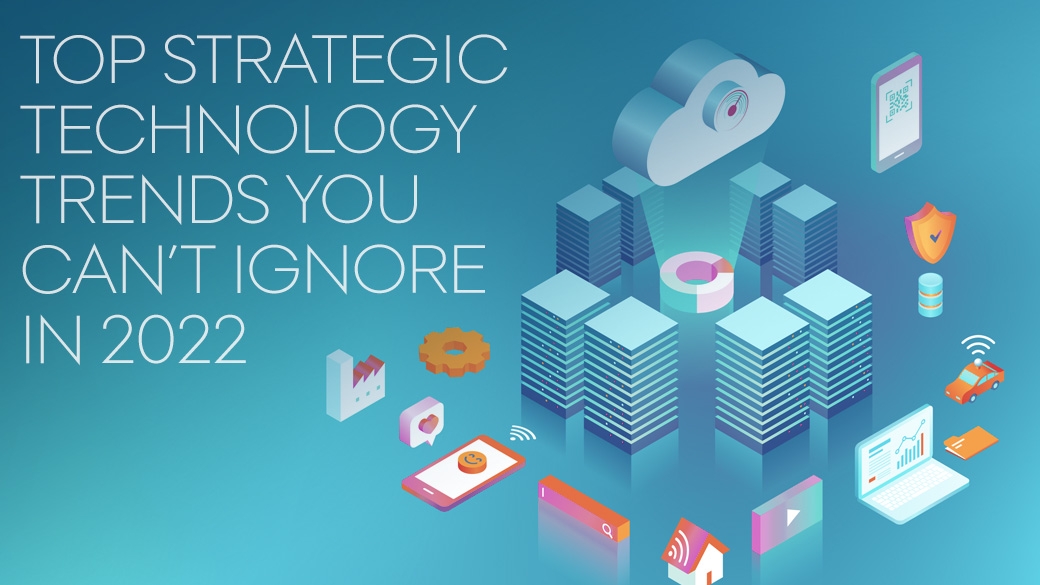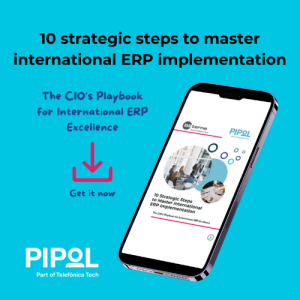Top strategic technology trends you can’t ignore in 2022

Every year, based on input from global CEOs, the Gartner Group shares its top upcoming technology trends. For 2022, they’ve identified 12 critical trends they believe will shape the future of business over the next three to five years. For organizations looking to stay ahead of the competition, these trends should be analyzed and used to define long-term roadmaps for business growth.
Gartner Top Strategic Technology Trends for 2022 are grouped into 3 categories based on their desired outcomes; technologies that help provide trusted digital connections, technologies that help organizations to scale their digital creativity, and technologies designed to accelerate business growth. Some of these technologies have been developing over the past few years, while others are only starting to emerge. But all of them have the capacity to accelerate digital capabilities and drive business growth in global organizations. Read more below about these top strategic technologies.
Providing trusted digital connections
Digital ecosystems rely heavily on trusted connections. But how do you guarantee that your data is integrated and processed securely across cloud and non-cloud environments? The four trends in this category are designed to help you create more resilient, scalable, and trusted IT foundations.
- Data Fabric
Regardless of where your data resides, it should always be accessible from everywhere. Data fabric offers a flexible and efficient way to manage your data allowing you to integrate data sources across platforms and business users. Using analytics, this technology can offer recommendations for where your data should be used and how it should be updated, dramatically reducing the cost of data management efforts by up to 70%. - Cybersecurity Mesh
Cybersecurity is a business problem for every organization. With cybersecurity mesh you can improve overall system security by integrating distributed, stand-alone security solutions. This flexible architecture allows you to move your control points so they are closer to the assets they’re protecting. It can scan cloud and non-cloud environments and informs you for instance about whether you are adhering to current policies.
- Privacy-Enhancing Computation
With ever-changing privacy and data protection laws combined with the growing concerns of consumers, the way organizations process personal data is becoming more and more critical. Privacy-enhancing computation uses various privacy-protection techniques to structure and manage personal data and ensure the highest level of protection. For instance, the cryptographic tool Multi-Party Computation (MPC) allows multiple parties to distribute and analyze data without violating compliance requirements. - Cloud-Native Platforms
Taking advantage of the speed, agility, and other benefits of the cloud, Cloud-Native Platforms are the modern, modular approach to building applications. This technology empowers organizations to develop and run resilient, agile applications in public, private, and hybrid cloud environments.
Technologies to help scale digital creativity
The previous four trends focused on creating a trusted foundation. The next four focus on helping organizations to scale and accelerate their digitalization efforts. They enable organizations to respond to changes by quickly developing applications to automate business activities, optimize AI, and enable faster and smarter decision-making.
5. Composable Applications
Built using business-centric modular components, composable applications enable the use and reuse of code ensuring accelerated time to market. These modular components can be fine-tuned to create new applications with even greater business value—where the functionality of the whole solution is truly greater than the sum of its parts.
6. Decision Intelligence
Decision intelligence is designed to support human decision-making by basing decisions on practical information derived from the system. It can turn information into better actions using intelligence and analytics to inform, learn from, and refine decisions. In the future, this technology could also potentially automate decision-making with the help of augmented analytics, simulations, and AI.
7. Hyperautomation
Global organizations are often looking for ways to scale automation capabilities. Hyperautomation uses advanced technologies to quickly identify, evaluate, and automate numerous business and IT processes. This smart concept determines what work to automate, chooses the appropriate automation tools, and drives agility by reusing existing automated processes. It also uses AI and machine learning to extend the capabilities of these tools enabling scalability, remote operations, as well as business model disruption.
8. AI Engineering
AI engineering focuses on creating tools, systems, and processes that enable the development and deployment of AI capabilities. By automating updates to data, models, and applications, AI engineering allows you to streamline AI and ensure these capabilities continue to add value to be business.
Innovations to accelerate business growth
The next four trends can help you identify new ways to win business and market share. These strategic technologies can unleash IT force multipliers enabling you to maximize value creation and enhance your digital capabilities.
9. Distributed Enterprises
With the increased demand for virtual services and hybrid workplaces, especially during COVID times, distributed enterprises help improve employee and product experiences as well as digitalize consumer and partner touchpoints. Focusing on a digital-first, remote-first business model, it’s designed to help organizations better serve the needs of remote employees and consumers.
10. Total Experience
Are you looking for an efficient way to improve customer and employee confidence, satisfaction, and loyalty? With a holistic approach to stakeholder management, Total experience integrates experiences across multiple touchpoints helping to accelerate growth.
11. Autonomic Systems
Adaptive systems are unique versions of existing technologies or tools. These self-managed systems learn from their environments and then dynamically optimize their behavior in real-time. By creating agile technology capabilities, they can support new requirements and situations, optimize performance, and ensure an extra level of defense against attacks without the need for human intervention.
12. Generative AI
Generative AI enables computers systems to learn from the data and then use this knowledge to generate similar content. For instance, these programs can use existing content such as text, images, or audio files, and create new content from the data. From the healthcare industry to software development, this innovative technology has the potential to create new creative content while also accelerating software development cycles.
The right model for your organization
With these emerging trends and innovations, there’s a broad range of choices for ERP deployment and selecting the most suitable solution depends on many factors. Remember, the different trends above can have different impacts on different organizations. It’s likely that organizations need different combinations of these technologies to be successful. What trends to select will depend on the CIOs and IT leaders understanding of their organizations’ short-term and strategic business objectives.
At Pipol, we understand that international organizations are unique and have specific requirements for data and functionality. We also understand the importance of keeping up to date on these industry trends so we can determine which ones are having the biggest impact on our customers. That’s why we have our finger on the pulse and will keep you updated about all the latest innovations.
If you’d like to discuss your organization’s own tech trends and challenges, just reach out. We can help you adopt the technologies you need for a successful 2022.
And if you’d like to read more on the Gartner Group’s top strategic technology trends for 2022, you can read the full article here or check out their eBook here.





